英语人教版九年级全册被动语态教学
- 格式:doc
- 大小:47.00 KB
- 文档页数:6
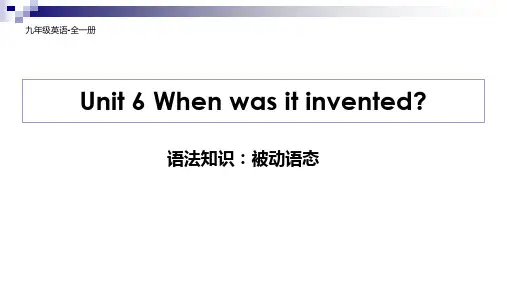
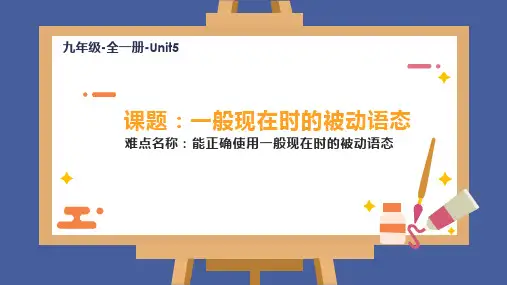
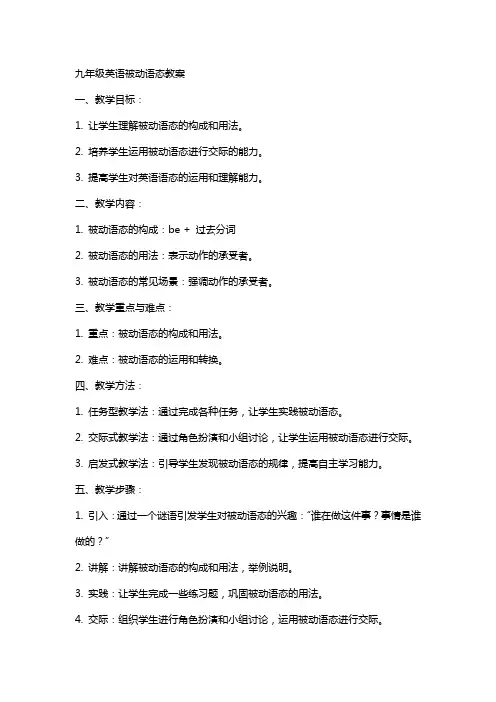
九年级英语被动语态教案一、教学目标:1. 让学生理解被动语态的构成和用法。
2. 培养学生运用被动语态进行交际的能力。
3. 提高学生对英语语态的运用和理解能力。
二、教学内容:1. 被动语态的构成:be + 过去分词2. 被动语态的用法:表示动作的承受者。
3. 被动语态的常见场景:强调动作的承受者。
三、教学重点与难点:1. 重点:被动语态的构成和用法。
2. 难点:被动语态的运用和转换。
四、教学方法:1. 任务型教学法:通过完成各种任务,让学生实践被动语态。
2. 交际式教学法:通过角色扮演和小组讨论,让学生运用被动语态进行交际。
3. 启发式教学法:引导学生发现被动语态的规律,提高自主学习能力。
五、教学步骤:1. 引入:通过一个谜语引发学生对被动语态的兴趣:“谁在做这件事?事情是谁做的?”2. 讲解:讲解被动语态的构成和用法,举例说明。
3. 实践:让学生完成一些练习题,巩固被动语态的用法。
4. 交际:组织学生进行角色扮演和小组讨论,运用被动语态进行交际。
5. 总结:对本节课的内容进行总结,强调被动语态的用法。
6. 作业:布置一些有关被动语态的练习题,让学生课后巩固。
六、教学评估:1. 课堂参与度:观察学生在课堂上的积极参与情况,以及他们在小组讨论和角色扮演中的表现。
2. 练习题完成情况:检查学生完成的练习题,评估他们对被动语态的理解和应用能力。
3. 口语表达:评估学生在口语交流中使用被动语态的准确性和流畅性。
七、拓展活动:1. 编写故事:让学生用被动语态编写一个简短的故事,强调动作的承受者。
2. 制作海报:学生分组制作海报,用被动语态描述海报主题,如:“被动语态在我们生活中的应用”。
八、课堂互动:1. 提问与回答:教师提出关于被动语态的问题,学生回答,促进师生互动。
2. 小组竞赛:设置小组竞赛,看哪个小组在练习中使用被动语态最准确、最流畅。
九、教学反思:1. 反思教学方法:思考本节课所采用的教学方法是否有效,是否需要调整。
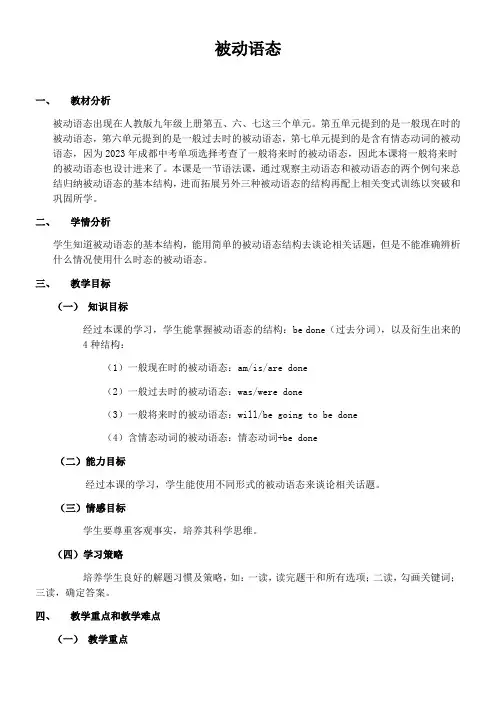
被动语态一、教材分析被动语态出现在人教版九年级上册第五、六、七这三个单元。
第五单元提到的是一般现在时的被动语态,第六单元提到的是一般过去时的被动语态,第七单元提到的是含有情态动词的被动语态,因为2023年成都中考单项选择考查了一般将来时的被动语态,因此本课将一般将来时的被动语态也设计进来了。
本课是一节语法课,通过观察主动语态和被动语态的两个例句来总结归纳被动语态的基本结构,进而拓展另外三种被动语态的结构再配上相关变式训练以突破和巩固所学。
二、学情分析学生知道被动语态的基本结构,能用简单的被动语态结构去谈论相关话题,但是不能准确辨析什么情况使用什么时态的被动语态。
三、教学目标(一)知识目标经过本课的学习,学生能掌握被动语态的结构:be done(过去分词),以及衍生出来的4种结构:(1)一般现在时的被动语态:am/is/are done(2)一般过去时的被动语态:was/were done(3)一般将来时的被动语态:will/be going to be done(4)含情态动词的被动语态:情态动词+be done(二)能力目标经过本课的学习,学生能使用不同形式的被动语态来谈论相关话题。
(三)情感目标学生要尊重客观事实,培养其科学思维。
(四)学习策略培养学生良好的解题习惯及策略,如:一读,读完题干和所有选项;二读,勾画关键词;三读,确定答案。
四、教学重点和教学难点(一)教学重点被动语态的结构:be done(过去分词)(1)一般现在时的被动语态:am/is/are done(2)一般过去时的被动语态:was/were done(3)一般将来时的被动语态:will/be going to be done(4)含情态动词的被动语态:情态动词+be done(二)教学难点使用不同形式的被动语态来谈论相关话题。
五、教学步骤(一)复习和热身教师呈现一张“Made in China”图片,激活学生被动语态的知识,并导入本课话题“passive voice(被动语态)”。
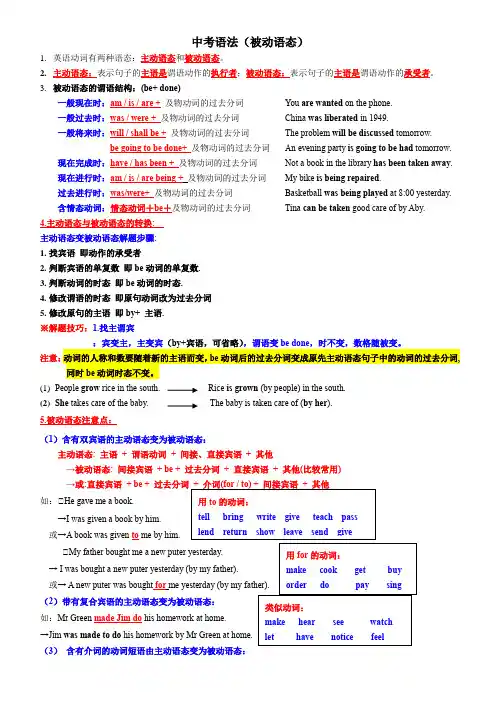
中考语法(被动语态)1. 英语动词有两种语态:主动语态和被动语态。
2. 主动语态:表示句子的主语是谓语动作的执行者;被动语态:表示句子的主语是谓语动作的承受者。
3. 被动语态的谓语结构:(be+ done)一般现在时:am / is / are + 及物动词的过去分词 You are wanted on the phone. 一般过去时:was / were + 及物动词的过去分词 China was liberated in 1949. 一般将来时:will / shall be + 及物动词的过去分词The problem will be discussed tomorrow. be going to be done+ 及物动词的过去分词An evening party is going to be had tomorrow. 现在完成时:have / has been + 及物动词的过去分词 Not a book in the library has been taken away . 现在进行时:am / is / are being + 及物动词的过去分词 My bike is being repaired .过去进行时:was/were+ 及物动词的过去分词Basketball was being played at 8:00 yesterday. 含情态动词:情态动词+be +及物动词的过去分词Tina can be taken good care of by Aby.4.主动语态与被动语态的转换: 主动语态变被动语态解题步骤: 1. 找宾语 即动作的承受者2. 判断宾语的单复数 即be 动词的单复数.3. 判断动词的时态 即be 动词的时态.4. 修改谓语的时态 即原句动词改为过去分词5. 修改原句的主语 即by+ 主语. ※解题技巧:1.找主谓宾:宾变主,主变宾(by+宾语,可省略),谓语变be done ,时不变,数格随被变。
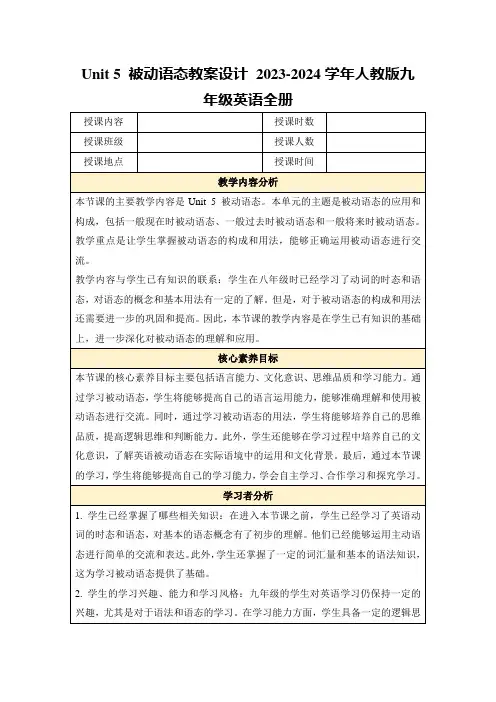
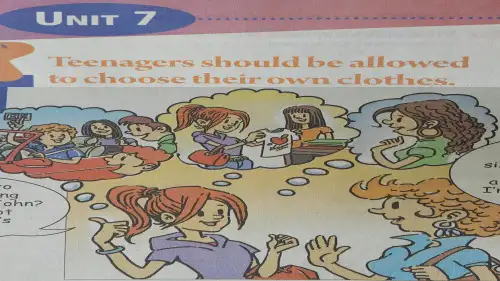
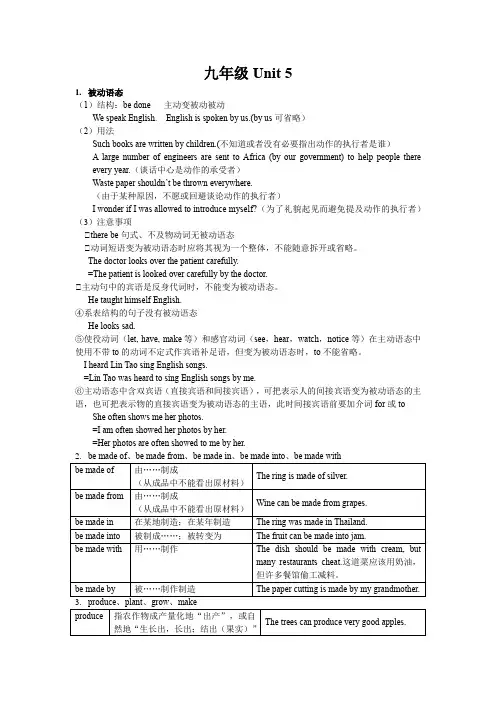
九年级Unit 51.被动语态(1)结构:be done 主动变被动被动We speak English. English is spoken by us.(by us可省略)(2)用法Such books are written by children.(不知道或者没有必要指出动作的执行者是谁)A large number of engineers are sent to Africa (by our government) to help people thereevery year.(谈话中心是动作的承受者)Waste paper shouldn’t be thrown everywhere.(由于某种原因,不愿或回避谈论动作的执行者)I wonder if I was allowed to introduce myself?(为了礼貌起见而避免提及动作的执行者)(3)注意事项①there be句式、不及物动词无被动语态①动词短语变为被动语态时应将其视为一个整体,不能随意拆开或省略。
The doctor looks over the patient carefully.=The patient is looked over carefully by the doctor.①主动句中的宾语是反身代词时,不能变为被动语态。
He taught himself English.④系表结构的句子没有被动语态He looks sad.⑤使役动词(let, have, make等)和感官动词(see,hear,watch,notice等)在主动语态中使用不带to的动词不定式作宾语补足语,但变为被动语态时,to不能省略。
I heard Lin Tao sing English songs.=Lin Tao was heard to sing English songs by me.⑥主动语态中含双宾语(直接宾语和间接宾语),可把表示人的间接宾语变为被动语态的主语,也可把表示物的直接宾语变为被动语态的主语,此时间接宾语前要加介词for或to She often shows me her photos.=I am often showed her photos by her.=Her photos are often showed to me by her.avoid sth/doing sthThe man is so cruel. You should try your best to avoid.Drivers should be careful to avoid some accidents.9.traffic un.____________________,常用heavy,much,a lot of,lots of修饰The traffic is heavy in rush hours.There is always a lot of traffic at this time of a day.traffic lights_____________ traffic jam_________________traffic rules____________ traffic accidents____________10.riserise v.__________,其过去式为________,过去分词为_________The sun rises in the east and sets in the west.12.be famous for______________ be famous as____________be famous to_________________be good for________________ no matter______________ even though__________________ traffic accident_____________ turn...into______________ go on a vacation______________ send out__________________ at festivals_____________ in trouble____________________ rise into__________________ fairy tale_______________ cover with___________________ historical story_____________ by hand_______________ all over the world______________ be used for________________ be used as_____________ be used to do sth______________ be/get used to doing sth_______________ paper cutting_____________练习题一、根据首字母或汉语提示,填写单词。

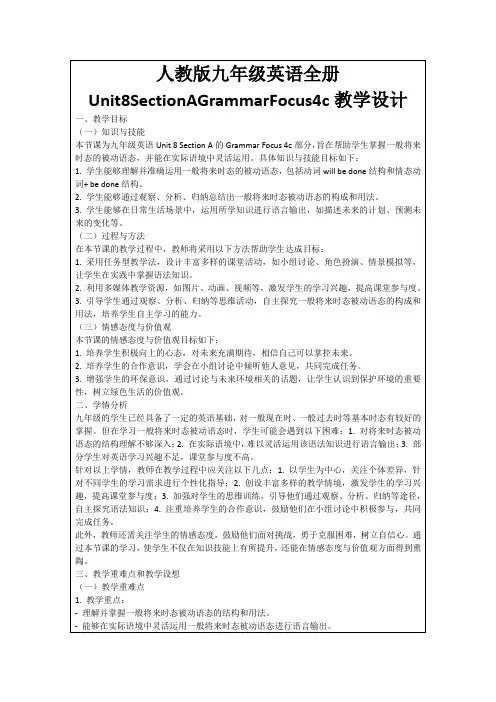
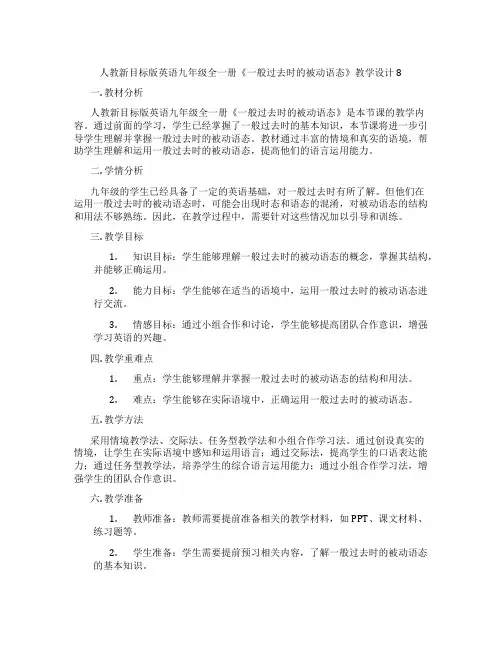
人教新目标版英语九年级全一册《一般过去时的被动语态》教学设计8一. 教材分析人教新目标版英语九年级全一册《一般过去时的被动语态》是本节课的教学内容。
通过前面的学习,学生已经掌握了一般过去时的基本知识,本节课将进一步引导学生理解并掌握一般过去时的被动语态。
教材通过丰富的情境和真实的语境,帮助学生理解和运用一般过去时的被动语态,提高他们的语言运用能力。
二. 学情分析九年级的学生已经具备了一定的英语基础,对一般过去时有所了解。
但他们在运用一般过去时的被动语态时,可能会出现时态和语态的混淆,对被动语态的结构和用法不够熟练。
因此,在教学过程中,需要针对这些情况加以引导和训练。
三. 教学目标1.知识目标:学生能够理解一般过去时的被动语态的概念,掌握其结构,并能够正确运用。
2.能力目标:学生能够在适当的语境中,运用一般过去时的被动语态进行交流。
3.情感目标:通过小组合作和讨论,学生能够提高团队合作意识,增强学习英语的兴趣。
四. 教学重难点1.重点:学生能够理解并掌握一般过去时的被动语态的结构和用法。
2.难点:学生能够在实际语境中,正确运用一般过去时的被动语态。
五. 教学方法采用情境教学法、交际法、任务型教学法和小组合作学习法。
通过创设真实的情境,让学生在实际语境中感知和运用语言;通过交际法,提高学生的口语表达能力;通过任务型教学法,培养学生的综合语言运用能力;通过小组合作学习法,增强学生的团队合作意识。
六. 教学准备1.教师准备:教师需要提前准备相关的教学材料,如PPT、课文材料、练习题等。
2.学生准备:学生需要提前预习相关内容,了解一般过去时的被动语态的基本知识。
七. 教学过程1.导入(5分钟)通过创设情境,如讲述一个发生在过去的故事,引导学生思考并回答:What happened? Who was involved in the story? 让学生初步接触一般过去时的被动语态。
2.呈现(10分钟)教师通过PPT展示一般过去时的被动语态的结构和用法,让学生直观地感知语言现象。
初三语法专项——被动语态复习教学设计Learning ObjectivesI. Knowledge Objectives•掌握三种时态的被动语态结构;•掌握被动语态的重难点内容(注意事项);II. Ability Objectives•拓展阅读:通过英文分级绘本阅读,强化语法复习;•锻炼中考试题解题能力。
III. Emotion and Attitude Objectives•同学们能够通过小组合作的方式达到互相帮助、共同进步的学习氛围;•通过绘本学习,让同学们对西方文化有更多的兴趣以及更多的了解。
IV. Learning Strategies•同学们能够熟悉被动语态解题技巧以及中考试题解题技巧Important and difficult pointsI. Important point•能够熟悉被动语态的基本时态结构及重难点内容II. Difficult point•能够在具体的语篇当中正确分析被动语态的用法Learning ProcedureSteps Aims Teacher’s activities Students’ activities TimeI. Warming- up To form a relaxingclass mode and getclosed to students.Greet students. Greet the teacher. 2minsII. Leading- in Lead in the topic. ①Show the objectives of thelesson.②Play a part of the cartoonJourney to the West.Watch the cartooncarefully and answer thequestions.5minsIII. Guided- learning. &Task 1: Group work ①Test students’ability: Studentsare able to figureout the mistakes inthe passage.②Review the basicrules of the PassiveVoice: Studentscan analyze andremember the rulesof Passive V oice.①Show the students a passageabout this part of cartoon;②Guide students to find out themistakes in the passage and correctthe mistake one by one.③Guide students to find out therelated rules and ask them to readaloud the examples.①Follow the teacher andread the passagecarefully;②Group work: Workwith group members andfind out the mistakes inthe passage as many aspossible.③Answer the teacher’squestions actively;④Try to remember therules and read aloud theexamples.10minsIV. Extended Reading Train students’reading skills andthe ability to solvethe problems inexercises.①Show the students the bookRoman Adventure.②Guide the students to talk aboutthe story.③Skimming: Ask them to read thestory quickly and silently, and findout the passive voice sentences asquickly as they can.④Intensive Reading: Ask them toread the story in details.⑤Teach students to understand thestory by using Story ElementsOrganizer.⑥Ask students to do someexercises.①Free answers to theteacher’s question.②Group work: Read thestory for the first timequickly and find out thepassive voice sentencesas quickly as they can.Discuss with their groupmembers and show theanswers to the teacher.20minsV.More Exercises (中考真题演练)Train students’more abilities bydoing exercises.Ask students to do some moreexercises. (If time is limited, thispart will be assigned as homework.)Students do the exercisescorrectly. (If time isenough.)5minsVI. Summary & homeworkStudents areexpected tosummarize thegrammar and dosome moreexercises afterclass.Review what we have learned inthis lesson and ask students to domore exercises after class.Try to remember therules of passive voiceand do more exercisesafter class.3min。
九年级英语UNIT 5语法知识一般现在时的被动语态一、定义被动语态表示句子的主语是谓语动词动作的承受者,或者主语是动作的对象。
结构:be(am/is/are)+done二、句式1.肯定句:主语+be(am/s/are)+done(+by...)2.否定句:主语+be(am/is/are)+not+done(+by...)3.一般疑问句: Be(Am/Is/Are)+主语+done(+by...)?答语:Yes,主语+be(am/is/are).或No, 主语+be(am/is/are)+not4.特殊疑问句:特殊疑问词+be(am/is/are)+主语+done(+by...)?三、主动语态变被动语态1.方法(1)确定主语和宾语并互换位置(2)谓语动词改为“be+done”结构(3)原主语改为by+宾格形式,有时可省略。
如: Farmers grow rice in spring,农民们在春天播种水稻。
→Rice is grown by farmers in spring.水稻在春天被农民们播种。
拓展:主动句中的谓语动词是have,own,belong to等表示归属的动词时,不能用于被动语态。
语法练习一、根据语境,用括号内所给单词的正确形式填空。
1. What _____ this kind of food _____ (call)in Japanese?2. This song _____ often _____ (sing)by us.3. School uniforms _____ (look)good on us.4. Where _____ the watch _____(make)?5.The girl _____ often_____(hear) to sing in the evening.6. The best materials _____ _____ (use)by the shop to make dresses7.Both English and French _____ _____ (speak)in Canada.8.Our classroom _____ _____ (clean)by us every day.9. _____ your _____ (take)good care of?10.The pen _____ (write) very smoothly.11.离开教室之前一定要确保灯都关了。
需要掌握的内容:①一般现在时的被动语态:结构主要是由:主语+be动词中的am,is,are+动词的过去分词。
②简单来说就是谓语部分一定要是be动词中的am,is,are+动词的过去分词③理解清楚动词过去分词:第一条:动词规则变化主要是ed结尾的(按照动词过去式添加背诵就可以)第二条:动词过去分词的不规则变化(参考课本后面的)一、添加动词的被动①see②watch③bring④buy⑤plant⑥sell⑦sing⑧make⑨produce⑩throw11do12invent13invite14eat15learn16finish17break18put19read20ride21say22tell23dig24light25find二、把下列的主动句改成被动句:1.I eat some vegetables.2.He plants a tree in the park.3.My mother buys a computer for me.4.I send an email to my father.5.We water the flowers.6.He invents many things.7.She invites the famous star to have dinner.8.We can speak English.9.They read books in the morning.10.He cleans his room every day.11.They do their homework at night.12.I break the glass.throw13.My mother lights the candles.throw14.They put the old things in the box.throw15.The farmer sells vegetables.throw三、翻译1、这个戒指是银的.2、棉花产于新疆.3、杭州因茶而出名.4、茶叶被手工采摘.5、他被送去了美国.6、黏土被手工捏形状.7、春节被中国人庆祝.8、电脑被用于查找资料.9、纸被剪.10、被子被叠.11、他的家庭作业被他准时完成.12、食物被保存在冰箱.13、运动会被举行.14、树被坎倒了.15、一个新的玩具在房间被发现.。
被动语态一、被动语态的意义: 语态用于说明主语和谓语的关系,它包括主动语态和被动语态。
主动语态表示主语是动作的执行者。
例如:We clean our classroom every day.被动语态表示主语是动作的承受者。
例如:Our classroom is cleaned by us every day.二、被动语态的构成:be + 动词的过去分词be 必须与主语的人称、数一致。
初中阶段应该掌握的被动语态的结构为:一般现在时的被动语态:am/ is / are+过去分词English is taught in that school. 那个学校教英语。
We are asked to answer some questions in class. 课上我们被要求回答一些问题。
I am often found by my brother first. 我经常第一个被发现。
一般过去时的被动语态:was/ were +过去分词The song was written by Shi Guangna. 那首歌是施光南写的。
These shoes were bought for my sisters. 这些鞋子是给我的姐妹们买的。
含有情态动词的被动语态:情态动词+be +过去分词That old woman must be sent to hospital at once. 那位老太太马上送医院。
She may be taken to the police station. 她可能会被带到警察局。
It can’t be written with pencils. 不能用铅笔写(它)。
其他形式的被动语态需要了解一下:1.动词不定式的被动语态:to be done2. 其他时态的被动语态:现在进行时被动语态:am/ is /are being done过去进行时被动语态:was/ were being done现在完成时被动语态:have/ has been done过去完成时被动语态:had been done一般将来时被动语态:will be doneam/ is/are going to be done过去将来时被动语态:would be donewas/ were going to be done三、主动语态变为被动语态的方法1.主动结构的宾语变为被动结构的主语。
They made this kite yesterday afternoon. This kite was made yesterday afternoon by them.昨天下午他们做了这只风筝。
这只风筝是他们昨天下午做的。
2.主动结构的谓语动词由主动语态变为被动语态。
We took the sick boy to hospital at once. The sick boy was taken to hospital at once.我们立刻把那个生病的男孩送到了医院。
那个生病的男孩立刻被送往了医院。
3.主动结构的主语变为介词by 的宾语。
She cleans all the desks every day. All the desks are cleaned by her every day.她每天擦所有的桌子。
每天所有的桌子都是她擦的。
4.带双宾语动词的主动结构可把直接宾语或间接宾语改为被动语态的主语。
He gave me a present on my birthday. 我生日那天他送了我一件礼物。
I was given a present on my birthday. / A present was given to me on my birthday.5.带复合宾语的动词变被动语态,只把宾语变为主语,原来的宾语补足语留在原处。
主动语态中,有些动词要求后面用不带to 的不定式作宾语补足语,若变为被动语态时,一律加to. 例如:1) She made her students do a lot of homework last Sunday.上个星期天,她让她的学生做了很多作业。
Her students were made to do a lot of homework last Sunday.上个星期天,她的学生被迫做了很多作业。
2) We often hear the boy play the piano in his room.我们经常听到这个男孩在房间时弹钢琴。
The boy is often heard to play the piano in his room.这个男孩经常被听到在房间里弹钢琴。
3) I let them go into the cinema first just now. 刚才我让他们先进电影院了。
They were let to go into the cinema first just now. 刚才他们被允许先进电影院了。
* 注意:1.不及物动词没有被动语态,但有的不及物动词后跟一个介词或副词,其作用相当于一个及物动词。
这时,介词或副词不能省。
例如:1) His father can look after him. He can be looked after by his father.他的父亲能够照顾他。
他能够被他的父亲照顾。
2)We took care of the old man last year. The old man was taken care of by us.去年我们照顾那位老人的。
去年那个老人是我们照顾的。
3) Her classmates often laugh at her. She is often laughed at by her classmates.她的同学经常笑她。
她经常被她的同学嘲笑。
4) The scientists found out a good idea at last. A good idea was found out by the scientists at last.最后,科学家们找到了一个好的办法。
一个好办法最后终于被科学家们找到了。
2.某些动词形式上是主动语态,但含有被动的意思。
This book sells well. 这本书畅销。
This coat feels smooth and soft. 这件大衣摸起来光滑柔软。
This kind of cloth washes well. 这种布很耐洗。
3.有些动词不能用被动语态。
如:happen, take placeWhat happened just now? 刚才发生什么事了?Great changes have taken place in my hometown since five years ago.五年以来,我的家乡发生的巨大的变化。
* growRice is grown in east and south China. 水稻生长在中国的东部和南部。
The rice in this field grows well. 这块田里的水稻长势不错。
* sellThis book sells well. 这本书很畅销。
This book is sold in that bookshop. 这本书那家书店有卖。
Exercises One单项选择( )1. She often _____ by her classmates.A. laughedB. laughed atC. laughingD. been laughed( )2. After the room ______, we’ll go on a holiday.A. paintB. paintsC. will paintD. is painted( )3. –Have all the students known that our class will visit the Great Wall tomorrow?-- Yes. Every student _______ about it.A. tellsB. toldC. was toldD. has told( )4. I wasn’t at home yesterday. I ______ t help with Tommy’s party.A. askedB. was askedC. was askingD. had asked( )5. This kind of car _____ well. It’s quite popular.A. sellB. sellsC. is soldD. is selling( )6. MADE IN CHINA can _______ on many things even in England.A. been seenB. seeC. seesD. saw( )7. Old people should _______ politely.A. be spokenB. speakC. be spoken toD. speaks( )8. –Have you heard of the tide wave?--Yes, I watched it on TV. Millions of people _________ in it.A. were killedB. killedC. killD. were killing( )9. I was surprised to hear that the colour TV set _______ him 8000 yuan.A. has costB. costC. costedD. was cost( )10. –What a beautiful TV set! How long have you had it?-- For two months. It _______ on my last birthday.A. is boughtB. buyC. boughtD. was bought( )11. I like this sweater because it ______ so soft and warm.A. is feelingB. feelsC. has feltD. is felt( )12. The children should _______ not to break the traffic rules.A. be told b. told C. tell D. telling( )13. The young trees ______ well if they _______.A. won’t grow, don’t take careB. don’t grow, are taken good care ofC. don’t grow, don’t take good care ofD. won’t grow, aren’t taken good care of ( )14. If the child _____ , please telephone the police.A. foundB. is foundC. will findD. has found( )15. Sheep _____ by farmers for _____ wool and meat.A.are kept , producingB. kept, makingC. keep, growingD. is kept, gettingExercises Two一、将下列句子译成中文。